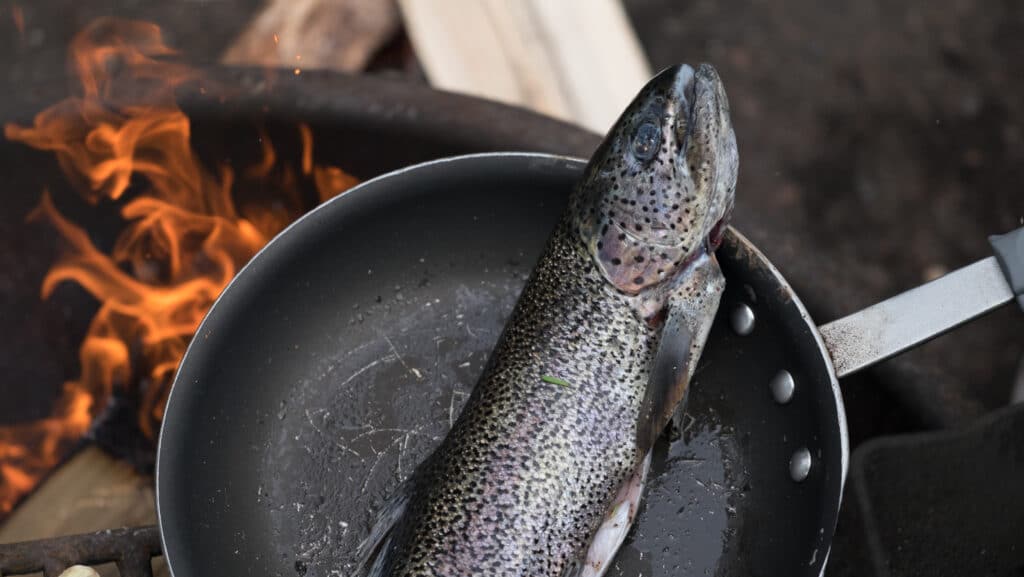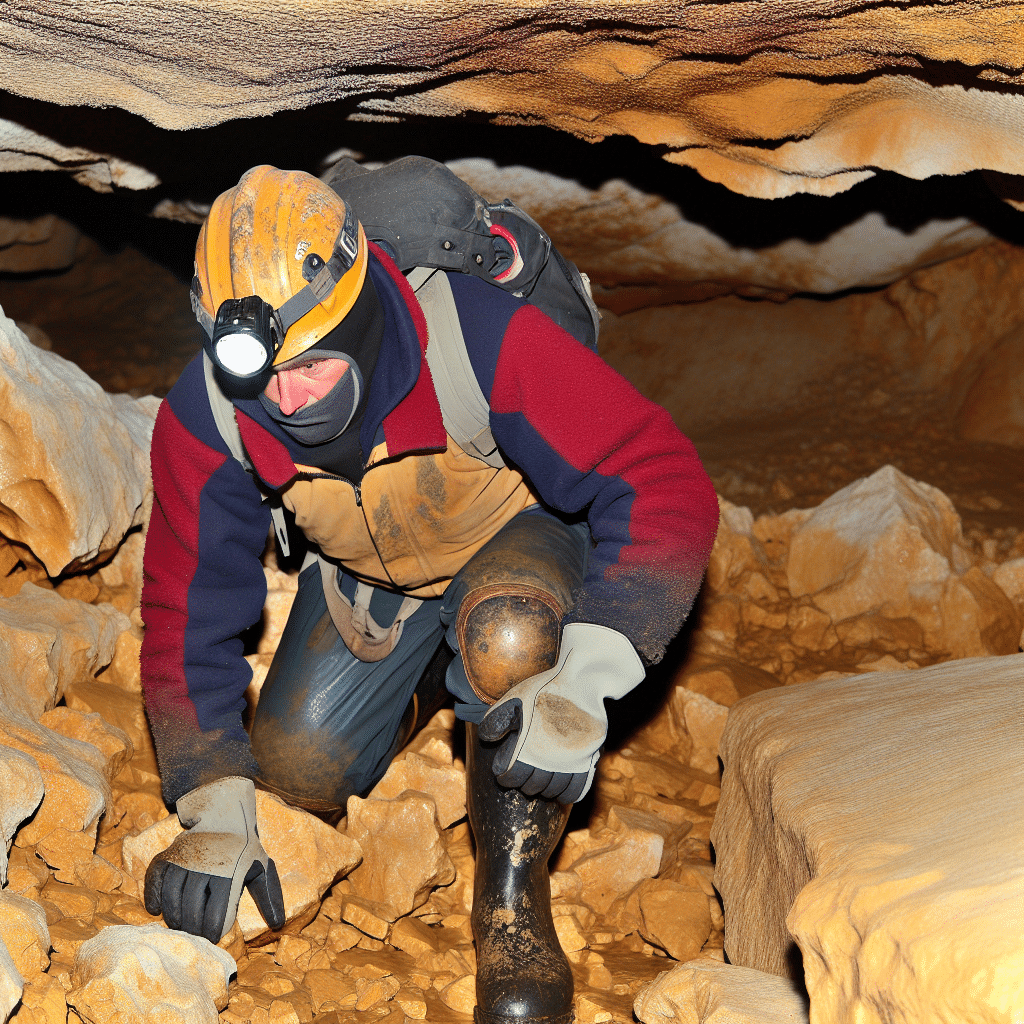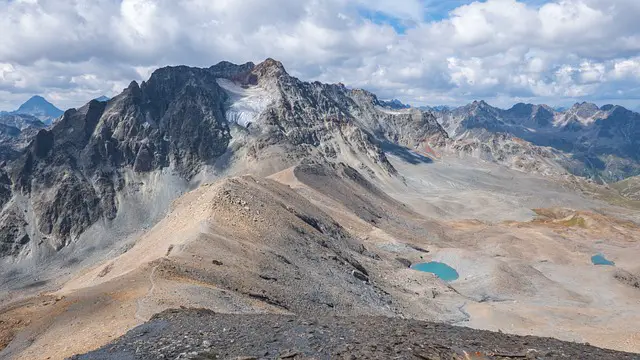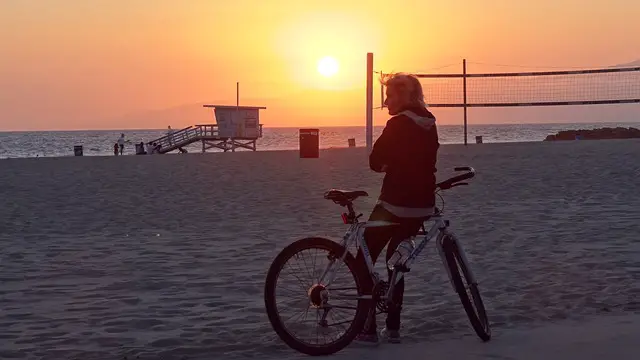Table of Contents
Fish while backpacking
When your out on a backpacking trip, you might want to get away from other people. Of course making camp in an area where it’s illegal to make camp can land you in trouble with the law. Then again, if you go off into relatively unpopulated areas then maybe you might enjoy catching some fish while out on the trail.

It can be a very rewarding experience. It’s also a good excuse to take a break from hiking, to just sit and catch some fish. Of course you have to know how to fish before going on a backpacking trip if you want to make sure you’ll come home with dinner…but I’m getting ahead of myself now.
First let me explain the easiest way for beginners as well as those who may not know anything about fishing. There are many types of gear available for catching fish but the simplest form of gear is simply a line and hook with bait attached. The bait can be any number of things depending on what type of fish you’re going for, but generally speaking worms or grubs work best when trying to catch fish in a lake or pond.
Live bait will give you more of a chance at catching fish, but bait on the store bought variety will work just fine if that’s all you have available to you.
I’ll use fishing line and hooks with night crawlers for this example. Night crawlers can be dug up in your backyard or bought from any number of stores that sell fishing gear. Take the hook and push it through the worm about one inch below where its tail springs out of its body, so about half an inch in. Make sure not to do it too deeply, because worms may try to pull themselves back into their holes if they notice something is wrong. Once the hook is through, flatten down the tail so it sticks against the rest of the worm, then push the hook through again. This time you want to do it in between where the tail springs out and its head is. Keep doing this until about two inches of the worm are on the hook (the more of the worm’s body that is hanging off will be better, because when you catch a fish with catch and release in mind, you don’t want to kill the fish by reeling him in too fast).
Put some bait on your hook…now go fishing!
You may need to move around once you’ve put your line into one spot in order to find out where there might be bigger fish located in order for you to get your bait in front of them. You can also try moving your rod up and down (or jigging it) in order to get a bite. You’ll be able to feel the movement of the fish’s mouth on your rod once he’s latched onto your bait, and you can then work at reeling him in.
If you want to catch smaller fish such as blue gill or crappie, try moving around until you find areas where there are brush piles, logs or other things that these types of fish hang out near…and cast your line into those areas.
Now what if you don’t know how to do any of this? Well then maybe you should go camping with someone who does know how to do this before embarking on your journey alone. Or perhaps there is someone back home an adventurous spirit like you, who would be willing to teach you these skills before you go on your trip.
The best time for beginners or those who don’t know how to fish is early morning right when the sun comes up, because that’s when the fish are most active and hungry. Once they get used to being fed by all of the visitors at their home (the lake or pond) than they will settle down into a more lethargic mode where it’ll become more difficult for them to find food. Also, novice anglers tend to have more luck during this time anyway…so there!
Fishing While Backpacking – Start With the Basics
The lightweight, compact fishing gear available these days makes it possible to take almost everything you’ll need for a day’s outing along with you on your backpacking trip. But the wisest course is to start with the basics – string and hook – and add only as much equipment as you can expect to use without starting a strain on your arms.
A simple piece of 4-pound monofilament line, size six or eight worm hook, two split shot sinkers, a pair of pliers and a tiny tackle box will provide more than enough equipment for most beginners. If trout is what you’re after then all that is needed are some flys tied specifically for that waterway – just tie them yourself from materials found in nature around you.
If you’re new to the sport of fishing as a backpacker, it’s best to avoid rods and reels altogether until you’ve had a chance to become familiar with your equipment and surroundings. It’ll help if someone is going along with you who can show you how everything works – or a book is handy that shows a picture of what each item looks like. If not, simply take along a short length of monofilament line (no more than 12 inches) with hook, split shot sinkers and pliers on one end. Tie the other end securely around a nearby tree branch near water level and use that as your “rod.” A handkerchief or bandanna tied to the end will do just fine as a “fishing lure.”
You can easily prepare your own “lures” from those all-natural items you’ll find as you hike along. All it takes is a few minutes, a file or sharp knife to smooth the edges and some split shot sinkers for weight. For instance, a piece of fruit will do just fine tied to a small stick as a worm substitute. Corn kernels, pine cone seeds and cedar berries are other choices that work well on trout water – just about anything that moves should attract these fish.
Add a bit of peanut butter to the top of one of these alternatives if you want something with an even stronger scent (fish love this!) – but avoid using bacon grease at all costs because it doesn’t sink well and can actually attract bears!
Fishing While Backpacking – Put Your Gear to the Test
In order to become a skilled angler while backpacking, it’s important to know how your equipment is going to handle under everyday conditions. Here are a few suggestions for setting up a testing station that will provide valuable lessons in field use before you set out on your trip:
To begin with, find a level piece of ground near water deep enough for wading – try picking one where there’s little chance of being noticed by other hikers. If possible, choose an area next to trees or brush piles along banks so that fish have some place to hide when frightened. In addition, do not attempt this test in an area where people might come across the gear and wonder why it’s there.
Take along a small container filled with worms or other live bait (pour out old ones found in tackle boxes) and head for the water. Angle for trout if that’s what you’re fishing, but catch whatever is available to take home as dinner. When you come back, gut each fish and filet it carefully – be sure to remove all of the bones! Next, cut up battery operated “buzzers” (the ones used for panfish) into pieces 1/4-inch wide and tie them on like lures. Do one test with straight monofilament line and another with rubber core sinkers tied directly onto it. Use only braided line on the third test for even more realistic conditions.
Fish with each rig until you have a good idea how it performs – monitor your line carefully as well as the knots and other connections. Monofilament breaks easily when wet so be especially careful! Be sure to pick up all tackle at the end of this trial run, then hide that gear somewhere other than home where curious children or pets can’t get into it. You should also store fishing equipment in sealed plastic bags to keep out moisture and prevent tangles during storage.
When you do finally go out on a backpacking fishing trip, take along only what you need – don’t make it complicated by adding too much stuff. The whole idea is not to hog space inside your pack with non-essentials. For example, don’t bring a fishing rod that breaks down into five or six pieces – one that is telescopic and made of tough aluminum is the best choice.
In many cases it’s better to have two good rods rather than three inferior ones because from time to time you will snag trees or branches hanging over rivers and lakes. In fact, all gear should be of the highest quality available for this reason alone – lost equipment can easily ruin a great trip!
For instance, do not attempt backpacking fishing with a rod made of black plastic tubing with wire running through it-it looks cheap and feels flimsy. These rods usually bend too much to set a hook firmly into a fish mouth anyway – another reason why they’re unacceptable for serious anglers.
Keep things as simple as possible when you begin backpacking fishing – this is one hobby where it’s easy to become totally confused if you let it happen! By using lightweight rods with the finest reels available, you can enjoy casting for hours without worrying about equipment problems. However, most professional sportsmen prefer spinning gear because it’s lighter and you don’t have to worry so much about the line getting tangled.
Of course, certain fly rods can also be used for backpacking fishing – but be aware that this is a major investment of time, money and energy! For example, tying flies is an art form in itself that few people care to learn even though some experts say it’s easier than using spinning or bait casting gear.
One of the best ways to learn about backpacking fishing is by trying it out in some nearby ponds and even small lakes. This way you can get an idea of what size fish are available, then buy equipment that matches your expected catch instead of the other way around!
Start in the smallest waters you can find and work your way up to larger lakes and even rivers in time. You’ll get a chance to test out different pieces of gear without ending up broke or broken at the end!
In addition, watch how other anglers use their rods and reels before hitting the trail yourself. In many cases, your first backpacking fishing trip will be rewarding if you choose your equipment carefully beforehand.
When you’re actually on the trail, fish are likely to be more skittish than usual because they can sense there’s something wrong with an inexperienced person handling a rod and reel! Hint: practice using equipment at home until it feels comfortable before hitting the trail.
For example, if you don’t feel confident about knowing how to cast, there are always videos that can help-or take a class before trying out backpacking fishing for the first time. When it comes to equipment, nothing is more important than learning about knots and other line connections. Try practicing with cheap tackle until you become familiar with the basic knots and how they’re used.
Fish are usually more active at night than during the day, so you should consider starting fishing then instead of waiting until late afternoon. If you need a little light to see what’s happening along the edge of a stream, use a flashlight covered with red cellophane tape – this will make it easier for you to see without disturbing the fish!
Also, it’s usually best to use live bait when fishing after dark because they become more active then. Some of the best baits for backpacking fishing include worms and crickets. Before setting up camp for the night, bury some worms near a clearing in trees along a river or lake – this is guaranteed to attract all kinds of fish !
When fishing in the evening, remember that you won’t be able to see as well as when it’s light. This is another reason why it’s a good idea to buy equipment with durable guides and reels before heading out on your first backpacking fishing trip.
Some experienced sportsmen still think it’s best to use spinning gear when fishing at night – this is because line twist can become a problem unless you have the latest reels. However, if you get your bait or lures snagged up easily, you should probably switch to fly rods before darkness sets in!
This is where many long-time anglers run into their first major problems – you need a special fly rod that’s easy to cast with even in low-light conditions. When backpacking fishing for the first time, remember that some equipment is better suited for certain types of water than others .
If you’re going to try out night fishing on long rivers or lakes, those big reels and heavy rods might be necessary. But with small ponds, ponds and creeks, you can use smaller equipment without worrying about fighting big fish or getting snagged on something underwater .
One of the best ways to find out which type of rod is best for backpacking fishing is to ask experienced sportsmen in your area. They’ll be able to tell you which types of fish are in the area, in addition to helping you choose a rod and reel that won’t break the bank.
How do you pack a fishing rod for backpacking?
The rod should be kept in a triangular rod case when you are backpacking fishing. This is the best method for protecting your equipment when it’s not being used.
Make certain that the lid of the case fits tightly over the base after you’ve inserted the rod, but before you’ve closed it firmly. This type of storage will keep your rod in good working condition even when it’s bouncing around in the back of your truck for several hours between fishing trips.
How do you carry a fishing pole while hiking?
There are two main ways to carry a fishing pole when you’re hiking. The first method is to fix the rod on top of your pack using the small loops at the top of the rod tube. You can attach a strap to these loops and fasten it to your pack, but this may not be necessary.
The second method is to use a proper sling while you are backpacking fishing. This allows your arms to hang at your sides while you are walking. A sling is a strip of material with loops on each end, which fit over the top section of your fishing rod. The fishing rod should have one or two small loops located near the top of the uppermost section so that they can be used for this purpose.
How do you cook trout when backpacking?
Trout are usually fried in a pan when they are prepared for dinner by campers. Bring along butter to cook the fish in, and remember a few seasonings to add flavor. Some good seasonings include salt, pepper and garlic powder.
To fry a trout after backpacking fishing, melt the butter in the pan and then hold the trout by its tail and dip it into the melted butter. Release the trout into the pan and cook until the fish becomes firm and white.
Can you eat the skin of a brook trout?
Some people prefer to eat the skin of a brook trout, but others remove it because it can be very fatty. If you are cooking or frying a brook trout, remove the skin and discard it before cooking.



